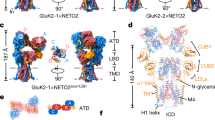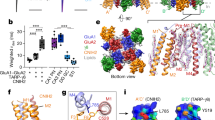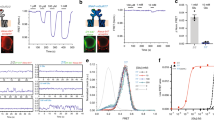Abstract
Ionotropic glutamate receptors principally mediate fast excitatory transmission in the brain. Among the three classes of ionotropic glutamate receptors, kainate receptors (KARs) have a unique brain distribution, which has been historically defined by 3H-radiolabeled kainate binding. Compared with recombinant KARs expressed in heterologous cells, synaptic KARs exhibit characteristically slow rise-time and decay kinetics. However, the mechanisms responsible for these distinct KAR properties remain unclear. We found that both the high-affinity binding pattern in the mouse brain and the channel properties of native KARs are determined by the KAR auxiliary subunit Neto1. Through modulation of agonist binding affinity and off-kinetics of KARs, but not trafficking of KARs, Neto1 determined both the KAR high-affinity binding pattern and the distinctively slow kinetics of postsynaptic KARs. By regulating KAR excitatory postsynaptic current kinetics, Neto1 can control synaptic temporal summation, spike generation and fidelity.
This is a preview of subscription content, access via your institution
Access options
Subscribe to this journal
Receive 12 print issues and online access
$209.00 per year
only $17.42 per issue
Buy this article
- Purchase on Springer Link
- Instant access to full article PDF
Prices may be subject to local taxes which are calculated during checkout







Similar content being viewed by others
References
Traynelis, S.F. et al. Glutamate receptor ion channels: structure, regulation, and function. Pharmacol. Rev. 62, 405–496 (2010).
Lerma, J. Kainate receptor physiology. Curr. Opin. Pharmacol. 6, 89–97 (2006).
Contractor, A., Mulle, C. & Swanson, G.T. Kainate receptors coming of age: milestones of two decades of research. Trends Neurosci. 34, 154–163 (2011).
Pinheiro, P.S. & Mulle, C. Presynaptic glutamate receptors: physiological functions and mechanisms of action. Nat. Rev. Neurosci. 9, 423–436 (2008).
Jane, D.E., Lodge, D. & Collingridge, G.L. Kainate receptors: pharmacology, function and therapeutic potential. Neuropharmacology 56, 90–113 (2009).
Foster, A.C., Mena, E.E., Monaghan, D.T. & Cotman, C.W. Synaptic localization of kainic acid binding sites. Nature 289, 73–75 (1981).
Castillo, P.E., Malenka, R.C. & Nicoll, R.A. Kainate receptors mediate a slow postsynaptic current in hippocampal CA3 neurons. Nature 388, 182–186 (1997).
Vignes, M. & Collingridge, G.L. The synaptic activation of kainate receptors. Nature 388, 179–182 (1997).
Kidd, F.L. & Isaac, J.T. Developmental and activity-dependent regulation of kainate receptors at thalamocortical synapses. Nature 400, 569–573 (1999).
Kidd, F.L. & Isaac, J.T. Kinetics and activation of postsynaptic kainate receptors at thalamocortical synapses: role of glutamate clearance. J. Neurophysiol. 86, 1139–1148 (2001).
Wu, L.J., Zhao, M.G., Toyoda, H., Ko, S.W. & Zhuo, M. Kainate receptor-mediated synaptic transmission in the adult anterior cingulate cortex. J. Neurophysiol. 94, 1805–1813 (2005).
Li, H. & Rogawski, M.A. GluR5 kainate receptor mediated synaptic transmission in rat basolateral amygdala in vitro. Neuropharmacology 37, 1279–1286 (1998).
Li, P. et al. Kainate-receptor-mediated sensory synaptic transmission in mammalian spinal cord. Nature 397, 161–164 (1999).
Bureau, I., Dieudonne, S., Coussen, F. & Mulle, C. Kainate receptor–mediated synaptic currents in cerebellar Golgi cells are not shaped by diffusion of glutamate. Proc. Natl. Acad. Sci. USA 97, 6838–6843 (2000).
Frerking, M., Malenka, R.C. & Nicoll, R.A. Synaptic activation of kainate receptors on hippocampal interneurons. Nat. Neurosci. 1, 479–486 (1998).
Wondolowski, J. & Frerking, M. Subunit-dependent postsynaptic expression of kainate receptors on hippocampal interneurons in area CA1. J. Neurosci. 29, 563–574 (2009).
Frerking, M. & Ohliger-Frerking, P. AMPA receptors and kainate receptors encode different features of afferent activity. J. Neurosci. 22, 7434–7443 (2002).
Sachidhanandam, S., Blanchet, C., Jeantet, Y., Cho, Y.H. & Mulle, C. Kainate receptors act as conditional amplifiers of spike transmission at hippocampal mossy fiber synapses. J. Neurosci. 29, 5000–5008 (2009).
Cunningham, M.O. et al. Neuronal metabolism governs cortical network response state. Proc. Natl. Acad. Sci. USA 103, 5597–5601 (2006).
Paternain, A.V., Rodríguez-Moreno, A., Villarroel, A. & Lerma, J. Activation and desensitization properties of native and recombinant kainate receptors. Neuropharmacology 37, 1249–1259 (1998).
Herb, A. et al. The KA-2 subunit of excitatory amino acid receptors shows widespread expression in brain and forms ion channels with distantly related subunits. Neuron 8, 775–785 (1992).
Heckmann, M., Bufler, J., Franke, C. & Dudel, J. Kinetics of homomeric GluR6 glutamate receptor channels. Biophys. J. 71, 1743–1750 (1996).
Schiffer, H.H., Swanson, G.T. & Heinemann, S.F. Rat GluR7 and a carboxy-terminal splice variant, GluR7b, are functional kainate receptor subunits with a low sensitivity to glutamate. Neuron 19, 1141–1146 (1997).
Traynelis, S.F. & Wahl, P. Control of rat GluR6 glutamate receptor open probability by protein kinase A and calcineurin. J. Physiol. (Lond.) 503, 513–531 (1997).
Swanson, G.T. & Heinemann, S.F. Heterogeneity of homomeric GluR5 kainate receptor desensitization expressed in HEK293 cells. J. Physiol. (Lond.) 513, 639–646 (1998).
Cui, C. & Mayer, M.L. Heteromeric kainate receptors formed by the coassembly of GluR5, GluR6, and GluR7. J. Neurosci. 19, 8281–8291 (1999).
Mott, D.D., Rojas, A., Fisher, J.L., Dingledine, R.J. & Benveniste, M. Subunit-specific desensitization of heteromeric kainate receptors. J. Physiol. (Lond.) 588, 683–700 (2010).
Erreger, K., Chen, P.E., Wyllie, D.J. & Traynelis, S.F. Glutamate receptor gating. Crit. Rev. Neurobiol. 16, 187–224 (2004).
Swanson, G.T. et al. Differential activation of individual subunits in heteromeric kainate receptors. Neuron 34, 589–598 (2002).
Bowie, D., Garcia, E.P., Marshall, J., Traynelis, S.F. & Lange, G.D. Allosteric regulation and spatial distribution of kainate receptors bound to ancillary proteins. J. Physiol. (Lond.) 547, 373–385 (2003).
Garcia, E.P. et al. SAP90 binds and clusters kainate receptors causing incomplete desensitization. Neuron 21, 727–739 (1998).
Laezza, F. et al. KRIP6: a novel BTB/kelch protein regulating function of kainate receptors. Mol. Cell. Neurosci. 34, 539–550 (2007).
Zhang, W. et al. A transmembrane accessory subunit that modulates kainate-type glutamate receptors. Neuron 61, 385–396 (2009).
Coussen, F. et al. Recruitment of the kainate receptor subunit glutamate receptor 6 by cadherin/catenin complexes. J. Neurosci. 22, 6426–6436 (2002).
Hirbec, H. et al. Rapid and differential regulation of AMPA and kainate receptors at hippocampal mossy fibre synapses by PICK1 and GRIP. Neuron 37, 625–638 (2003).
Ng, D. et al. Neto1 is a novel CUB-domain NMDA receptor–interacting protein required for synaptic plasticity and learning. PLoS Biol. 7, e41 (2009).
Mulle, C. et al. Altered synaptic physiology and reduced susceptibility to kainate-induced seizures in GluR6-deficient mice. Nature 392, 601–605 (1998).
Michishita, M. et al. Expression of Btcl2, a novel member of Btcl gene family, during development of the central nervous system. Brain Res. Dev. Brain Res. 153, 135–142 (2004).
Berger, M. & Ben-Ari, Y. Autoradiographic visualization of [3H]kainic acid receptor subtypes in the rat hippocampus. Neurosci. Lett. 39, 237–242 (1983).
Tomita, S., Fukata, M., Nicoll, R.A. & Bredt, D.S. Dynamic interaction of stargazin-like TARPs with cycling AMPA receptors at synapses. Science 303, 1508–1511 (2004).
Kwon, H.B. & Castillo, P.E. Role of glutamate autoreceptors at hippocampal mossy fiber synapses. Neuron 60, 1082–1094 (2008).
Salinas, G.D. et al. Actinfilin is a Cul3 substrate adaptor, linking GluR6 kainate receptor subunits to the ubiquitin-proteasome pathway. J. Biol. Chem. 281, 40164–40173 (2006).
Fernandes, H.B. et al. High-affinity kainate receptor subunits are necessary for ionotropic but not metabotropic signaling. Neuron 63, 818–829 (2009).
Pinheiro, P. & Mulle, C. Kainate receptors. Cell Tissue Res. 326, 457–482 (2006).
Lerma, J. Roles and rules of kainate receptors in synaptic transmission. Nat. Rev. Neurosci. 4, 481–495 (2003).
Barberis, A., Sachidhanandam, S. & Mulle, C. GluR6/KA2 kainate receptors mediate slow-deactivating currents. J. Neurosci. 28, 6402–6406 (2008).
Contractor, A. et al. Loss of kainate receptor-mediated heterosynaptic facilitation of mossy-fiber synapses in KA2−/− mice. J. Neurosci. 23, 422–429 (2003).
Michishita, M. et al. A novel gene, Btcl1, encoding CUB and LDLa domains is expressed in restricted areas of mouse brain. Biochem. Biophys. Res. Commun. 306, 680–686 (2003).
Tomita, S. et al. Stargazin modulates AMPA receptor gating and trafficking by distinct domains. Nature 435, 1052–1058 (2005).
Acknowledgements
We thank members of the Tomita and Castillo laboratories for helpful discussions. We thank M.T.W. Ho for technical advice on slice preparation, G. Somers for maintaining mouse colonies, S.F. Heinemann (Salk Institute) for generating GluK2 knockout mice and the KOMP for creating Neto1 KO mice. S.T. and P.E.C. are supported by grants from the US National Institutes of Health/National Institute of Mental Health (R01 MH085080 and R01 MH081935, respectively). C.S. is supported by a Boehringer-Ingelheim PhD fellowship. M.W. is supported by Grants-in-Aid for Scientific Research (19100005) provided by the Ministry of Education, Culture, Sports, Science and Technology of Japan.
Author information
Authors and Affiliations
Contributions
S.T. and P.E.C. conceived the project and wrote the manuscript. C.S., D.L.H., M.Y., K.S.K., M.W. and S.T. performed all of the experiments and analyzed results. All of the authors, C.S. and D.L.H. in particular, contributed to the final version of the manuscript.
Corresponding authors
Ethics declarations
Competing interests
The authors declare no competing financial interests.
Supplementary information
Supplementary Text and Figures
Supplementary Figures 1–8 (PDF 13292 kb)
Rights and permissions
About this article
Cite this article
Straub, C., Hunt, D., Yamasaki, M. et al. Distinct functions of kainate receptors in the brain are determined by the auxiliary subunit Neto1. Nat Neurosci 14, 866–873 (2011). https://doi.org/10.1038/nn.2837
Received:
Accepted:
Published:
Issue Date:
DOI: https://doi.org/10.1038/nn.2837
This article is cited by
-
Kainate receptor auxiliary subunit NETO2 is required for normal fear expression and extinction
Neuropsychopharmacology (2019)
-
Damaging coding variants within kainate receptor channel genes are enriched in individuals with schizophrenia, autism and intellectual disabilities
Scientific Reports (2019)
-
Exciting Times: New Advances Towards Understanding the Regulation and Roles of Kainate Receptors
Neurochemical Research (2019)
-
NETO1 Regulates Postsynaptic Kainate Receptors in CA3 Interneurons During Circuit Maturation
Molecular Neurobiology (2019)
-
The Role of Kainate Receptors in the Pathophysiology of Hypoxia-Induced Seizures in the Neonatal Mouse
Scientific Reports (2018)



